Depositional and Diagenetic Controls on Reservoir Quality of Callovian-Oxfordian Stage on the Right Bank of Amu Darya
Abstract
:1. Introduction
2. Geological Setting
2.1. Geographical Information and History of Petroleum Exploration and Production
2.2. Major Geological Characteristics of Petroleum System
2.3. Location of Study Area and Main Target Strata
3. Data and Methods
3.1. Petrography
3.2. Reservoir Quality
4. Results
4.1. Facies Analysis
4.2. Diagenesis
4.2.1. Reservoir Quality Reducing Diagenetic Processes
- (1)
- Cementation
- (2)
- Compaction
4.2.2. Reservoir Quality Enhancing Diagenetic Processes
- (1)
- Dissolution
- (2)
- Fracturing
4.3. Reservoir Quality
4.3.1. Flow Unit
4.3.2. Pore Types
- (1)
- Primary pore types
- (2)
- Secondary pore types
- (3)
- Micropores
5. Discussion
5.1. Sedimentary Model
5.2. Diagenesis History
- (1)
- Syngenetic diagenensis: In the sedimentary environment of biological reef and shoal facies with high-energy, the porosity was reduced and the reservoir performance deteriorated due to edged asaphopsoides isopachous calcite cementation and equigranular calcite cementation. The main pore types at this stage are the remaining primary pores like interparticle pores, intraskeletal and coelomopore pores.
- (2)
- Early diagenesis: This stage is characterized by diagenetic processes such as mechanical compaction and chemical compaction (pressure solution), equigranular calcite cementation, and intergrowth calcite cementation. The reservoir is dominated by the remaining primary pores, as the number of primary pores was severely reduced.
- (3)
- Early middle diagenesis: At this stage, intergrowth calcite cementation occurred, and chemical compaction was further strengthened, but local strong diagenetic fracturing and dissolution improved the reservoir quality. The reservoir space is still dominated by remaining primary pores, with a few secondary pores.
- (4)
- Late middle diagenesis: The main diageneses are dissolution and fracturing, as well as secondary pores such as intergranular dissolution pores and intragranular dissolution pores, mold pores, intercrystalline dissolution pores, vugs, and fractures were widely developed.
5.3. Controlling Factors of the Reservoir Quality
5.3.1. Dissolved Grain-Dominated Reservoir Facies—RF1
5.3.2. Compacted/Cemented Grain-Dominated Reservoir Facies—RF2
5.3.3. Packstone/Wackstone Dominated Reservoir Facies—RF3
5.3.4. Microporous Mudstone-Dominated Reservoir Facies—RF4
5.3.5. Fracturing Mudstone-Dominated Reservoir Facies—RF5
6. Conclusions
- (1)
- Through facies analysis, we believe that the Callovian period is a gentle slope carbonate platform sedimentary model, which mainly includes four sedimentary facies belts, namely, the inner ramp, mid ramp, outer ramp, and basin. The Oxfordian period is an edged shelf-type carbonate platform sedimentary model, which mainly includes 15 sedimentary facies deposited in seven sedimentary facies belts, namely, the evaporative platform, restricted platform, open platform, platform margin, platform fore-edge upslope, platform fore-edge downslope, and basin facies.
- (2)
- The diagenesis fields of carbonate rocks in the Callovian-Oxfordian stage include atmospheric freshwater, shallow burial, and medium-deep burial environments. The main diagenetic processes include four-stage cementation, mechanical compaction, chemical compaction (pressure solution), dissolution, and fracturing, among which the dissolution and fracturing are the main processes that improve reservoir quality.
- (3)
- The main primary and secondary pore types in the target formation were identified; nine FUs were determined using the flow unit index method; five reservoir facies, as well as their reservoir quality and variation characteristics, were identified according to rock texture and flow characteristics, diagenesis, and pore types.
- (4)
- The reservoir quality evaluation revealed that the reservoir facies with the highest reservoir quality is RF1, which is the highest storage capacity and has strong flow capacity. Its corresponding flow units are FU4, FU5, and FU6. The reservoir facies with the second highest reservoir quality is RF2, and its corresponding flow units are FU3 and FU4, which are less distributed in the target intervals. RF4 has the lowest reservoir quality, and its corresponding flow units are FU1 and FU2, which mainly form an interlayer that blocks the fluid flow. Despite its very low storage capacity, RF5 serves mainly as a flow channel for the fluid in the Callovian-Oxfordian Stage due to the development of micro-fractures.
Author Contributions
Funding
Conflicts of Interest
References
- Ulmishek, G.F. Petroleum Geology and Resources of the Amu Darya Basin, Turkmenistan, Uzbekistan, Afghanistan and Iran; USGS: Reston, VA, USA, 2004; pp. 1–38.
- Xu, S.; Wang, S.; Sun, X. Petroleum geology and resource potential. Oil Forum 2007, 6, 31–38. [Google Scholar]
- Zhang, B.; Zheng, R.; Liu, H. Characteristics of Carbonate Reservoir in Callovian-Oxfordian of Samandepe Gas field Turkmenistan. Acta Geol. Sin. 2010, 84, 117–125. [Google Scholar]
- Zheng, R.; Liu, H.; Wu, L. Geochemical characteristics and diagenetic fluid of the Callovian-Oxfordian carbonate reservoirs in Amu Darya basin. Acta Petrol. Sin. 2012, 28, 961–970. [Google Scholar]
- Wen, H.; Gong, B.; Zheng, R. Deposition and Diagenetic System of Carbonate in Callovian-Oxfordian of Samandepe Gas field, Turkmenistan. J. Jilin Univ. Earth Sci. Ed. 2012, 42, 991–1002. [Google Scholar]
- Liu, S.; Zheng, R.; Yan, W. Characteristics of Oxfordian carbonate reservoir in Agayry area, Amu Darya Basin. Lithol. Reserv. 2012, 24, 57–63. [Google Scholar]
- Dong, X.; Zheng, R.; Wu, L. Diagenesis and porosity evolution of carbonate reservoirs in Samandepe Gas Field, Turkmenistan. Lithol. Reserv. 2010, 22, 54–61. [Google Scholar]
- Xu, W.; Zheng, R.; Fei, H. The sedimentary facies of Callovian-Oxfordian Stage in Amu Darya basin, Turkmenistan. Geol. China 2012, 39, 954–964. [Google Scholar]
- Xu, W.; Zheng, R.; Fei, H. Characteristics and timing of fractures in the Callovian-Oxfordian boundary of the right bank of the Amu Darya River Turkmenistan. Nat. Gas Ind. 2012, 32, 33–38. [Google Scholar]
- Wang, L.; Zhang, Y.; Wu, L. Characteristics and identification of bioherms in the Amu Darya Right Bank Block, Turkmenistan. Nat. Gas Ind. 2010, 30, 30–33. [Google Scholar]
- Zeng, Z.; Chen, F.; Chen, Z. Forward Modeling of Callovian-Oxfordian Reefs of Upper Jurassic in AS Block of Amu Darya Right Bank in Turkmenistan. Xinjiang Pet. Geol. 2011, 32, 201–203. [Google Scholar]
- Zhang, W.; Liu, X.; Zhang, M. Forward Seismic Modeling and its Response of Point reef Reservoir in Amu Darya Area of Turkmenistan. J. Oil Gas Technol. 2011, 33, 72–75. [Google Scholar]
- Lucia, F.J. Carbonate Reservoir Characterization: An Integrated Approach; Springer Science & Business Media: Berlin/Heidelberg, Germany, 2007. [Google Scholar]
- Ahr, W.M. Geology of Carbonate Reservoirs: The Identification, Description and Characterization of Hydrocarbon Reservoirs in Carbonate Rocks; John Wiley & Sons: Hoboken, NJ, USA, 2011. [Google Scholar]
- Mehrabi, H.; Ranjbar-Karami, R.; Roshani-Nejad, M. Reservoir rock typing and zonation in sequence stratigraphic framework of the Cretaceous Dariyan Formation, Persian Gulf. Carbonates Evaporites 2019, 34, 1833–1853. [Google Scholar] [CrossRef]
- Mehrabi, H.; Bahrehvar, M.; Rahimpour-Bonab, H. Porosity evolution in sequence stratigraphic framework: A case from Cretaceous carbonate reservoir in the Persian Gulf, southern Iran. J. Petrol. Sci. Eng. 2021, 196, 107699. [Google Scholar] [CrossRef]
- Lv, G.; Liu, H.; Zhang, B.; Deng, M.; Zhang, X. Exploration and Development of Large Sub-Salt Carbonate Gas Fields on Right Bank of Amu Darya; Science Press: Beijing, China, 2013. [Google Scholar]
- Dunham, R.J. Classification of carbonate rocks according to their depositional texture. In Classification of Carbonate Rocks; Ham, W.E., Ed.; American Association of Petroleum Geologists Memoir: Tulsa, OK, USA, 1962; Volume 1, pp. 108–121. [Google Scholar]
- Embry, A.F.; Klovan, J.E. A late devonian reef tract on northeastern banks Island, NWT. Can. Pet. Geol. Bull. 1971, 19, 730–781. [Google Scholar]
- Flügel, E. Microfacies of Carbonate Rocks: Analysis, Interpretation and Application; Springer Science & Business Media: Berlin/Heidelberg, Germany, 2010. [Google Scholar]
- Amaefule, J.O.; Altnubay, M.; Tiab, D.; Kersey, D.G.; Keeland, D.K. Enhanced reservoir description: Using core and log data to identify hydraulic (flow) units and predict permeability in un-cored intervals/wells. Soc. Pet. Eng. 1993, 26436, 1–16. [Google Scholar]
- Kozeny, J. Ber Kapillare Leitung des Wassers im Boden, Sitzungsberichte; Royal Academy of Science Vienna: Vienna, Austria, 1927; Volume 136, pp. 271–306. [Google Scholar]
- Carman, P.C. Fluid flow through granular beds. Trans. Inst. Chem. Eng. 1937, 15, 150–166. [Google Scholar] [CrossRef]
- Gomes, J.S.; Riberio, M.T.; Strohmenger, C.J.; Negahban, S.; Kalam, M.Z. Carbonate Reservoir Rock Typing the Link between Geology and SCAL; SPE: Abu Dhabi, United Arab Emirates, 2008; p. 118284. [Google Scholar]
- Rahimpour-Bonab, H.; Mehrabi, H.; Navidtalab, A.; Izadi-Mazidi, E. Flow unit distribution and reservoir modeling in Cretaceous carbonates of the Sarvak Formation, Abteymour Oilfield, Dezful embayment, SW IRAN. J. Pet. Geol. 2012, 35, 1–24. [Google Scholar] [CrossRef]
- Mehrabi, H.; Rahimpour-Bonab, H.; Enayati-Bidgoli, A.H.; Esrafili-Dizaji, B. Impact of contrasting paleoclimate on carbonate reservoir architecture: Cases from arid Permo-Triassic and humid Cretaceous platforms in the south and southwestern Iran. J. Pet. Sci. Eng. 2015, 126, 262–283. [Google Scholar] [CrossRef]
- Tiab, D.; Donaldson, E.C. Petrophysics: Theory and Practice of Measuring Reservoir Rock and Fluid Transport Properties, 2nd ed.; Gulf Professional Publishing, Elsevier: Amsterdam, The Netherlands, 2004. [Google Scholar]
- Deng, Y.; Wang, Q.; Cheng, X.; Wu, L.; Zhao, C.; Chen, R. Origin and distribution laws of H2S in carbonate gas reservoirs in the Right Bank Block of the Amu Darya River. Nat. Gas Ind. 2011, 31, 21–23. [Google Scholar]
- Burrowes, A.; Moss, A.; Sirju, C.; Pritchard, T. Improved Permeability Prediction in Heterogeneous Carbonate Formations; Society of Petroleum Engineers: Barcelona, Spain, 2010; p. 131606. [Google Scholar]
- Enayati-Bidgoli, A.H.; Rahimpour-Bonab, H.; Mehrabi, H. Flow unit characterization in the Permian-Triassic carbonate reservoir succession at South Pars Gas field, of shore Iran. J. Pet. Geol. 2014, 37, 205–230. [Google Scholar] [CrossRef]
- Sfdari, E.; Kadkhodaie-Ilkhchi, A.; Rahimpour-Bonab, H.; Soltani, B. A hybrid approach for lithofacies characterization in the framework of sequence stratigraphy: A case study from the South Pars gas field, the Persian Gulf basin. J. Pet. Sci. Eng. 2014, 121, 87–102. [Google Scholar] [CrossRef]
- Nabawy, B.S. Impacts of the pore- and petro-fabrics on porosity exponent and lithology factor of Archie’s equation for carbonate rocks. J. Afr. Earth Sci. 2015, 108, 101–114. [Google Scholar] [CrossRef]
- Jamalian, M.; Adabi, M.H.; Moussavi, M.R.; Sadeghi, A.; Baghbani, D.; Ariyafar, B. Facies characteristic and paleoenvironmental reconstruction of the lower cretaceous fahliyan formation in the Kuh-e-siah area, Zagros basin, southern Iran. Facies 2011, 57, 101–122. [Google Scholar] [CrossRef]
- Wolpert, P.; Bartenbach, M.; Suess, P.; Rausch, R.; Aigner, T.; Le Nindre, Y.M. Facies analysis and sequence stratigraphy of the uppermost Jurassic–Lower Cretaceous Sulaiy Formation in outcrops of central Saudi Arabia. GeoArabia 2015, 20, 67–122. [Google Scholar] [CrossRef]
- Noori, H.; Mehrabi, H.; Rahimpour-Bonab, H.; Faghih, A. Tectono-sedimentary controls on Lower Cretaceous carbonate platforms of the central Zagros, Iran: An example of rift-basin carbonate systems. Mar. Pet. Geol. 2019, 110, 91–111. [Google Scholar] [CrossRef]
- Lee, E.Y.; Kominz, M.; Reuning, L.; Gallagher, S.J.; Takayanagi, H.; Ishiwa, T.; Knierzinger, W.; Wagreich, M. Quantitative compaction trends of Miocene to Holocene carbonates off the west coast of Australia. Aust. J. Earth Sci. 2021, 68, 1149–1161. [Google Scholar] [CrossRef]
- Tavakoli, V.; Rahimpour-Bonab, H.; Esrafili-Dizaji, B. Diagenetic controlled reservoir quality of South Pars gas field, an integrated approach. Comptes. Rendus Geosci. 2011, 343, 55–71. [Google Scholar] [CrossRef]
- Enayati-Bidgoli, A.; Navidtalab, A. Effects of progressive dolomitization on reservoir evolution: A case from the Permian–Triassic gas reservoirs of the Persian Gulf, offshore Iran. Mar. Pet. Geol. 2020, 119, 104480. [Google Scholar] [CrossRef]
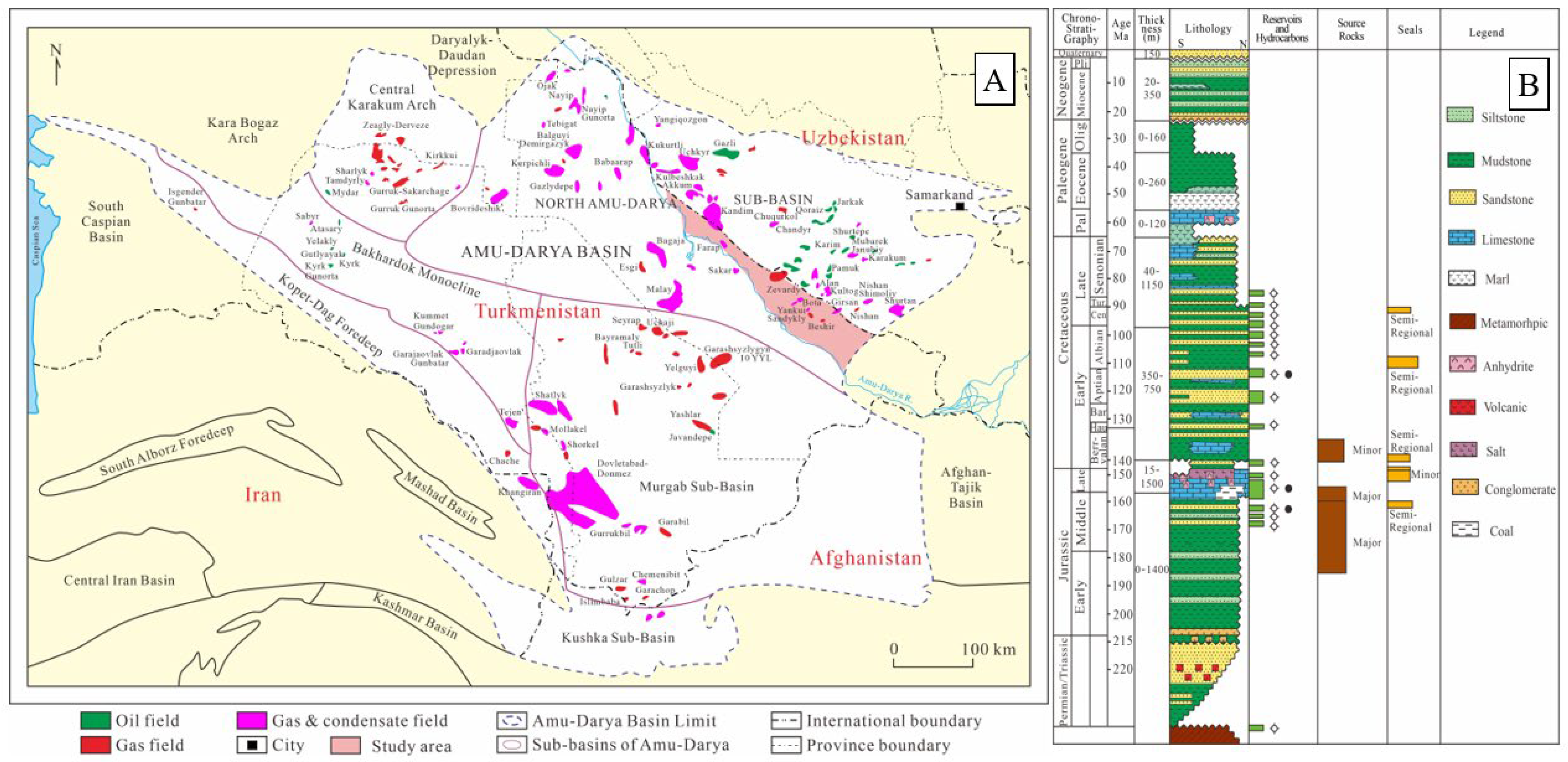
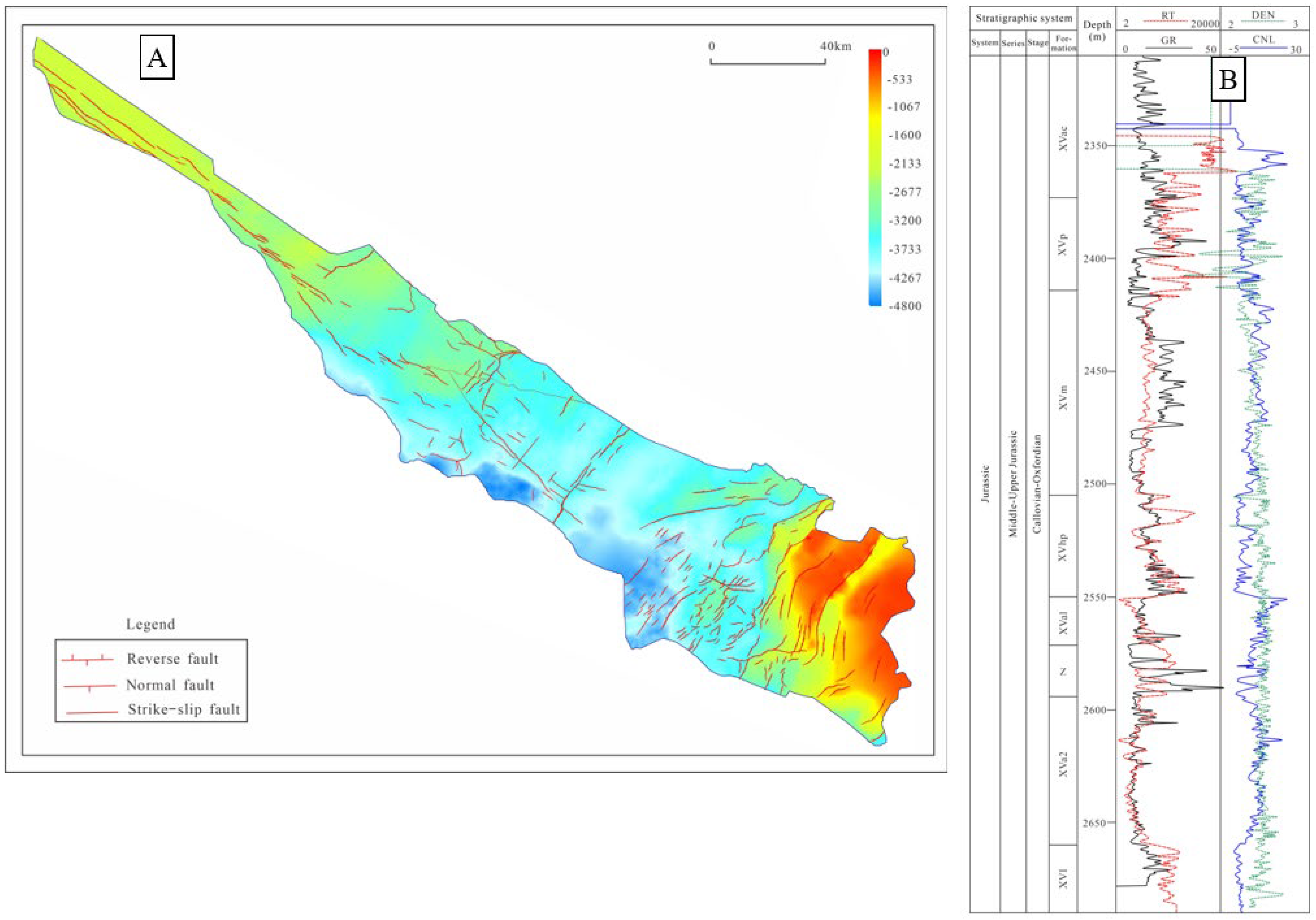

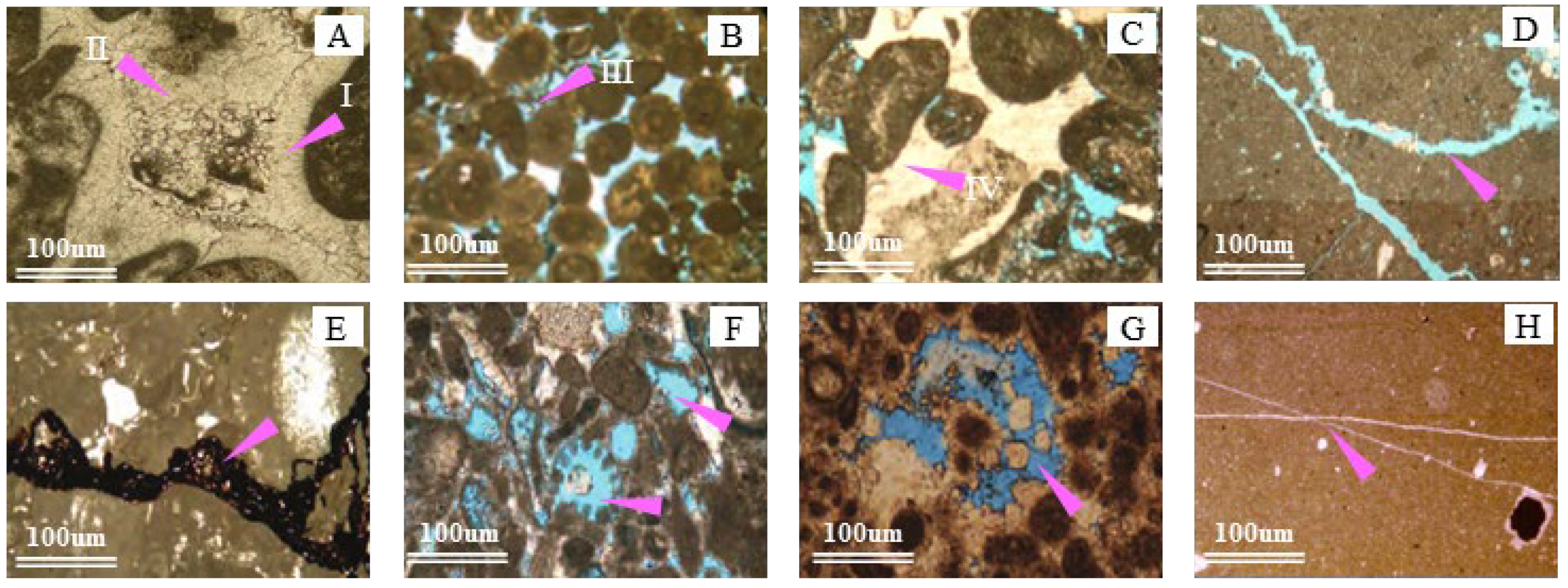
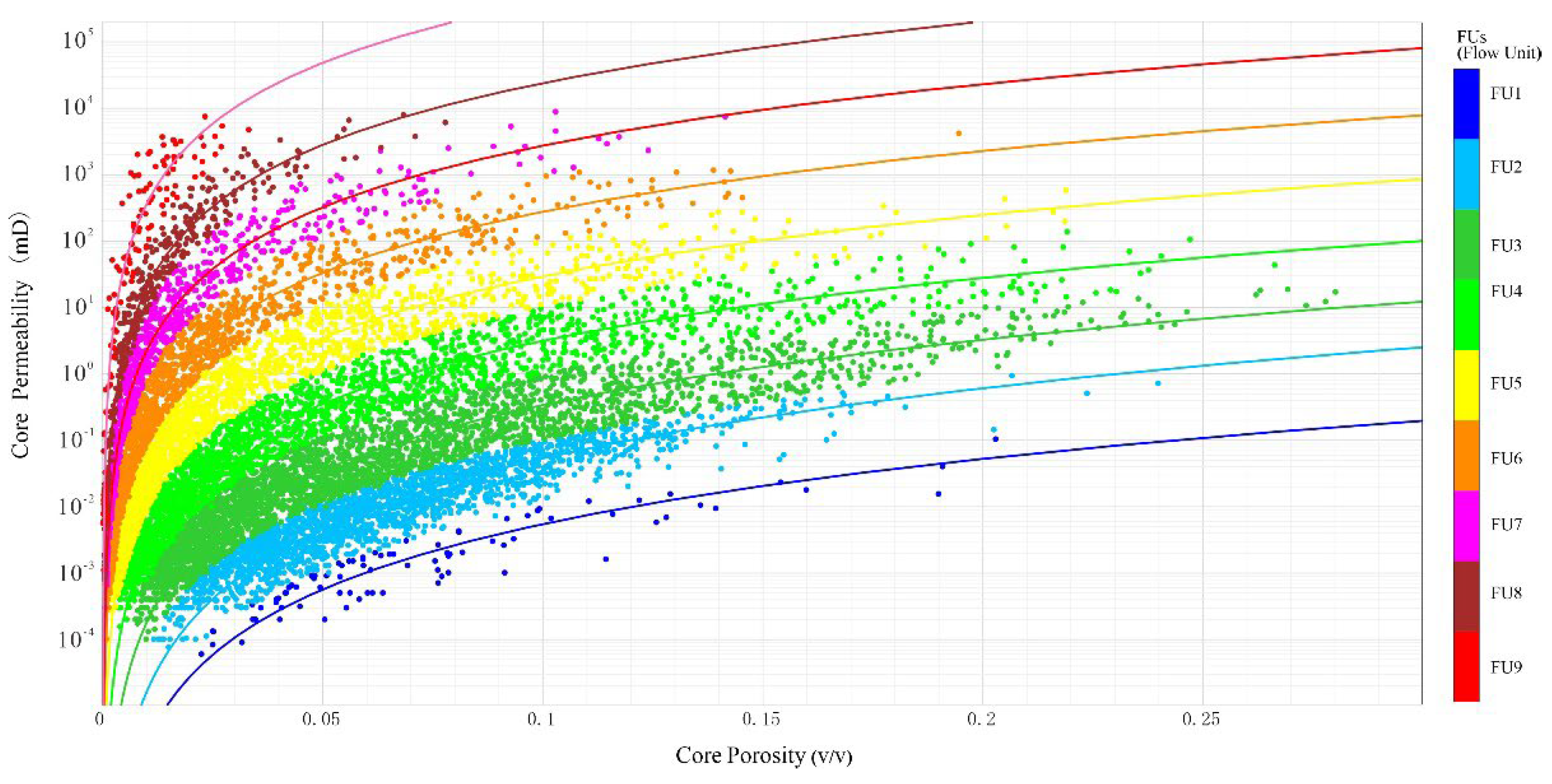
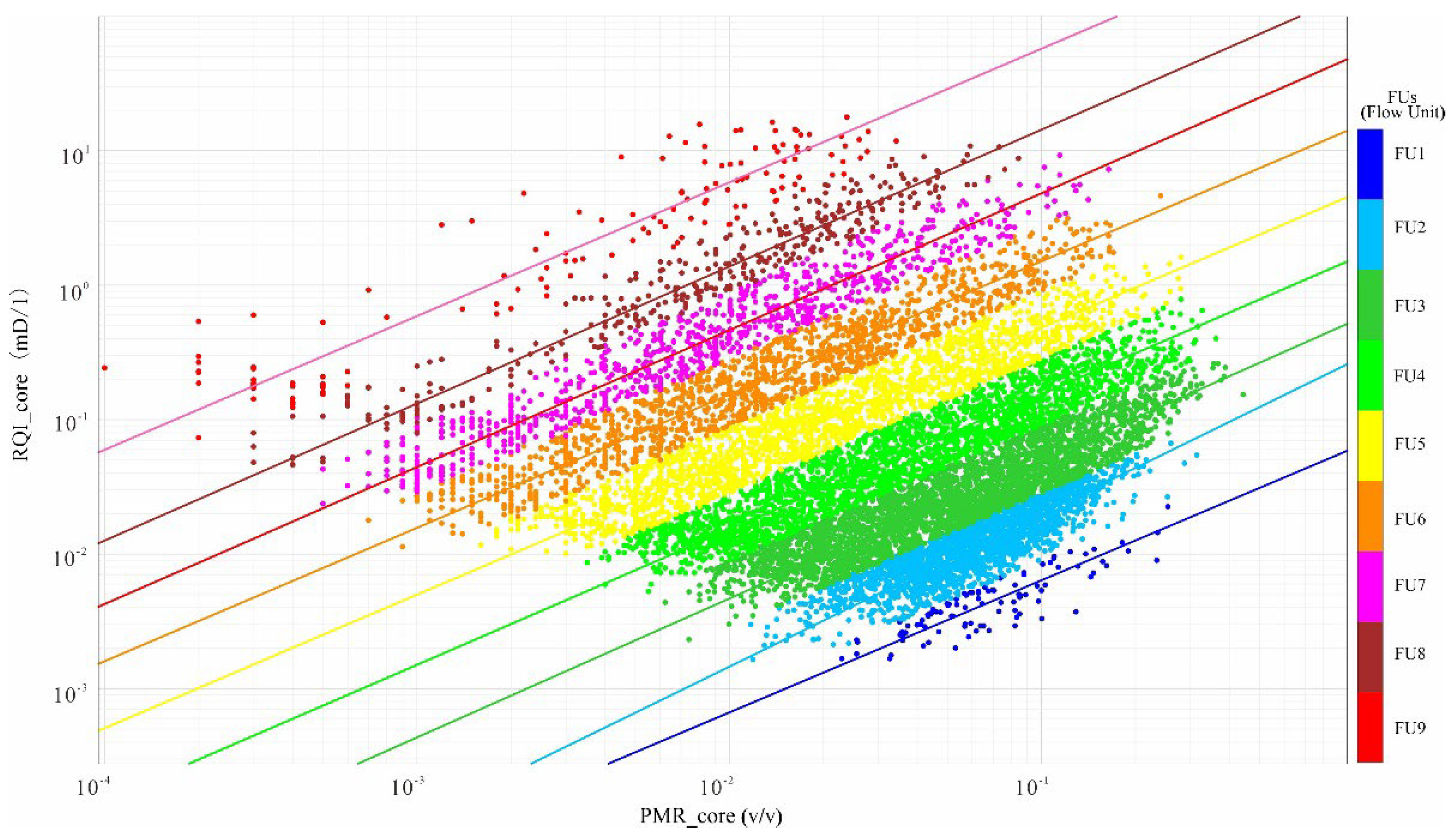

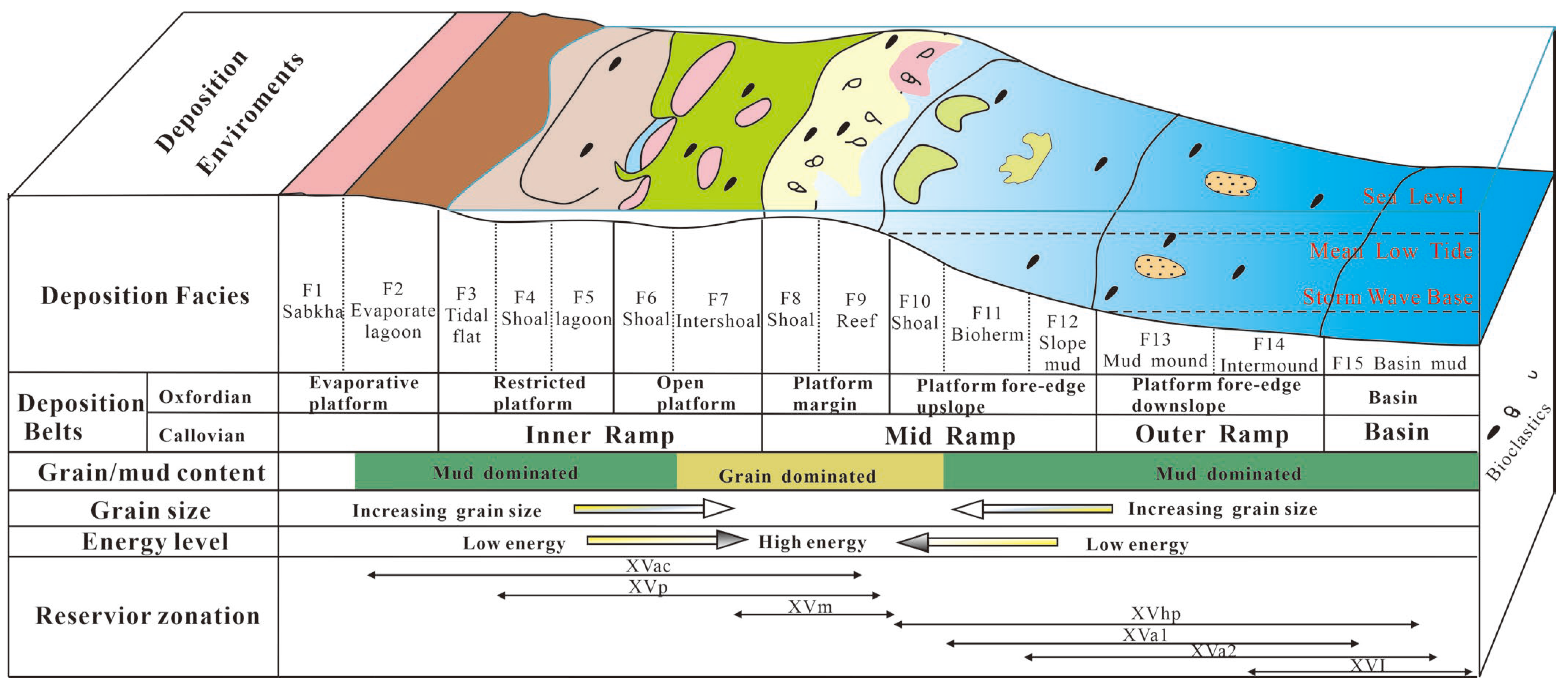


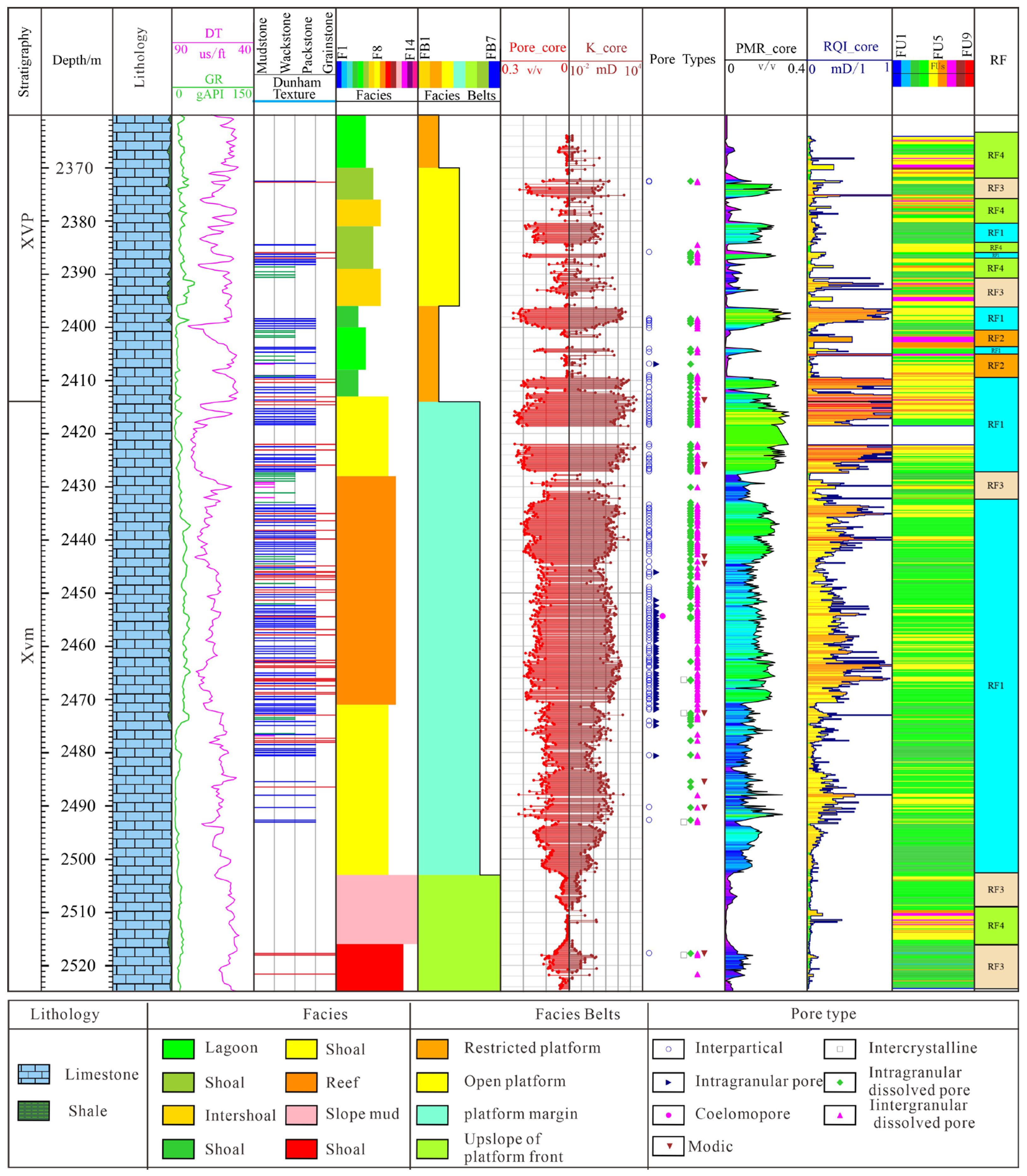

| Facies Belts | Facies | Main Lithology | Texture | Sorting | Energy Level | ||
|---|---|---|---|---|---|---|---|
| Name | Code | Name | Code | ||||
| Evaporative platform | FB1 | Sabkha | F1 | Gypsum | Mudstone | -- | Low |
| Evaporation lagoon | F2 | Gypsum-bearing limestone | Mudstone | -- | Low | ||
| Restricted platform | FB2 | Tidal flat | F3 | Algal limestone | Mud/packstone | Poor | Low |
| Restricted platform shoal | F4 | Micrite oolitic limestone | Pack/Wackstone | Well | High | ||
| Lagoon | F5 | Bioclastic micrite | Wack/packstone | Poor | Low | ||
| Open platform | FB3 | Open platform shoal | F6 | Bioclastic limestone | Grain/packstone | Well | High |
| Inter-shoal | F7 | Bioclastic micrite | Wack/packstone | Poor | Low | ||
| platform Margin | FB4 | Platform margin shoal | F8 | Biosparitic calcirudite | Grainstone | Well | High |
| Organic reef | F9 | Reef (Bioclastic) limestone | Grainstone | Poor | High | ||
| Platform fore-edge upslope | FB5 | Shoal (upslope) | F10 | Bioclastic limestone | Grainstone | Medium | High |
| Bioherm | F11 | Micritic grainstone | Grain/packstone | Poor | High | ||
| Mud (upslope) | F12 | Micrite | Wack/mudstone | Poor | Low | ||
| Platform fore-edge downslope | FB6 | Lime-mud mound | F13 | Micrite boundstone | Wack/packstone | Poor | Low |
| Mud (downslope) | F14 | Micrite | Wack/mudstone | Poor | Low | ||
| Basin | FB7 | Basin mud | F15 | Argillaceous limestone mudstone | Mudstone | Poor | Very low |
| FU1 | FU2 | FU3 | FU4 | FU5 | FU6 | FU7 | FU8 | FU9 | ||
|---|---|---|---|---|---|---|---|---|---|---|
| Porosity (%) | Min | 2.3 | 1.2 | 0.7 | 0.4 | 0.2 | 0.1 | 0.1 | 0.00 | 0.00 |
| Max | 20.3 | 24.0 | 30.7 | 26.6 | 24.9 | 20.5 | 14.2 | 7.8 | 0.8 | |
| Mean | 7.3 | 6.4 | 6.6 | 6.1 | 4.3 | 2.4 | 1.6 | 1.4 | 0.5 | |
| Permeability (mD) | Min | 0.000 | 0.000 | 0.000 | 0.000 | 0.000 | 0.000 | 0.000 | 0.001 | 0.001 |
| Max | 0.103 | 0.925 | 18.469 | 162.00 | 769.80 | 4189.5 | 8801.3 | 7874.3 | 7405.8 | |
| Mean | 0.004 | 0.026 | 0.406 | 4.330 | 18.528 | 44.772 | 118.20 | 296.04 | 662.93 | |
| Reservior Quality Index (RQI) | Min | 0.002 | 0.002 | 0.003 | 0.005 | 0.01 | 0.011 | 0.023 | 0.050 | 0.073 |
| Max | 0.022 | 0.066 | 0.260 | 0.819 | 1.970 | 4.610 | 9.170 | 10.750 | 17.720 | |
| Mean | 0.005 | 0.014 | 0.039 | 0.113 | 0.222 | 0.392 | 0.800 | 2.020 | 4.680 | |
| Flow Zone Indicator (FZI) | Min | 0.029 | 0.090 | 0.282 | 0.892 | 2.819 | 8.927 | 28.210 | 89.407 | 283.47 |
| Max | 0.089 | 0.282 | 0.891 | 2.818 | 8.912 | 28.128 | 88.967 | 278.354 | 2381.5 | |
| Mean | 0.066 | 0.193 | 0.526 | 1.644 | 5.073 | 16.168 | 48.338 | 143.885 | 685.95 |
| RF1 | RF2 | RF3 | RF4 | RF5 | ||
|---|---|---|---|---|---|---|
| Porosity (%) | Min | 2.9 | 2.9 | 3.0 | 0.0 | 0.0 |
| Max | 25.0 | 19.7 | 11.8 | 3.2 | 2.8 | |
| Mean | 14.3 | 11.2 | 5.9 | 1.3 | 1.1 | |
| Permeability (mD) | Min | 1.900 | 0.004 | 0.004 | 0.0001 | 0.009 |
| Max | 2701.400 | 3.200 | 0.170 | 0.121 | 3985.800 | |
| Mean | 22.500 | 0.500 | 0.016 | 0.006 | 1.820 | |
| Reservoir quality Index(RQI) | Min | 0.007 | 0.007 | 0.002 | 0.002 | 0.064 |
| Max | 0.235 | 0.235 | 0.070 | 0.535 | 17.719 | |
| Mean | 0.483 | 0.078 | 0.017 | 0.024 | 0.363 | |
| Ratio of Porosity to Matrix (PMR) | Min | 0.030 | 0.030 | 0.031 | 0.000 | 0.000 |
| Max | 0.389 | 0.261 | 0.137 | 0.033 | 0.032 | |
| Mean | 0.127 | 0.103 | 0.064 | 0.014 | 0.016 | |
| Flow zone indicator (FZI) | Min | 0.164 | 0.038 | 0.028 | 0.070 | 2.200 |
| Max | 343.653 | 7.542 | 2.010 | 2303.910 | 2381.515 | |
| Mean | 4.535 | 0.864 | 0.282 | 2.556 | 26.837 |
Publisher’s Note: MDPI stays neutral with regard to jurisdictional claims in published maps and institutional affiliations. |
© 2022 by the authors. Licensee MDPI, Basel, Switzerland. This article is an open access article distributed under the terms and conditions of the Creative Commons Attribution (CC BY) license (https://creativecommons.org/licenses/by/4.0/).
Share and Cite
Xing, Y.; Wang, H.; Zhang, L.; Cheng, M.; Shi, H.; Guo, C.; Chen, P.; Yu, W. Depositional and Diagenetic Controls on Reservoir Quality of Callovian-Oxfordian Stage on the Right Bank of Amu Darya. Energies 2022, 15, 6923. https://doi.org/10.3390/en15196923
Xing Y, Wang H, Zhang L, Cheng M, Shi H, Guo C, Chen P, Yu W. Depositional and Diagenetic Controls on Reservoir Quality of Callovian-Oxfordian Stage on the Right Bank of Amu Darya. Energies. 2022; 15(19):6923. https://doi.org/10.3390/en15196923
Chicago/Turabian StyleXing, Yuzhong, Hongjun Wang, Liangjie Zhang, Muwei Cheng, Haidong Shi, Chunqiu Guo, Pengyu Chen, and Wei Yu. 2022. "Depositional and Diagenetic Controls on Reservoir Quality of Callovian-Oxfordian Stage on the Right Bank of Amu Darya" Energies 15, no. 19: 6923. https://doi.org/10.3390/en15196923
APA StyleXing, Y., Wang, H., Zhang, L., Cheng, M., Shi, H., Guo, C., Chen, P., & Yu, W. (2022). Depositional and Diagenetic Controls on Reservoir Quality of Callovian-Oxfordian Stage on the Right Bank of Amu Darya. Energies, 15(19), 6923. https://doi.org/10.3390/en15196923







